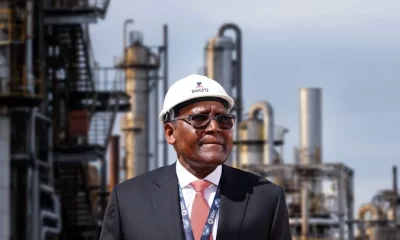Column
In Fairness To NLNG
Sometime in the late 1990s when the initial construction phases of the liquefied natural gas (LNG) plant on Bonny Island were still ongoing, the Nigeria LNG Limited (NLNG) arranged for a delegation of some prominent Bonny indigenes to visit a similar LNG project jointly financed by Petronas (Malaysia’s national oil company), Shell and Mitsubishi in 1978 and which was already operational on the Malaysian Island of Bintulu.
My uncle and the then Secretary of Jumbo Major House of Bonny, Warisenibo Henderson Jumbo, was on that delegation. I remember publishing a full-page interview which I had with him regarding the trip back then. He was, indeed, the first person on that trip to publicly hint at the size and potentials of what was coming to Grand Bonny Kingdom.
The smooth, safe and peaceful relocation of the entire Finima community had already been concluded then, thanks to the negotiating skills of Chief Israel Idamiebi-Brown during the series of negotiations in London and elsewhere. For displaying stunning adroitness, he was often lifted shoulder high by his jubilant kinsmen on returning from some of those conferences. The legal luminary and former Rivers State Attorney-General and Commissioner of Justice may also have been on the Bintulu facility tour.
New Finima, as it was then called, was next to pure heaven. In fact, early visitors to the place may have turned green with envy on seeing the alluring design and pattern of new residences and the fact that some of the natives who had just been evacuated from mostly congested, leaking huts and dilapidated block houses were now proud owners of out-spaced modern homes, paved roads and recreational grounds, among other social amenities.
In those days, transportation from Bonny main town to Finima and back was free as there was literally an ubiquity of brand new airconditioned Toyota Coaster buses running an almost 18-hour service daily. Indeed, I can recall making about three sightseeing trips on a particular day from Bonny to the new settlement while still seated in the same bus, free of charge. Some there were who made more of such trips daily, almost converting it to a regular pastime.
For me, that period was quite epochal as it marked the beginning of the trust and sincerity of purpose between NLNG and Grand Bonny Kingdom which, from all indications, have endured to this day.
At the peak of construction work on the NLNG base project, it is on record that TSKJ and its numerous subcontractors engaged about 18,000 workers. And their presence mounted enormous pressure on the then available social infrastructure in Bonny and its hinter communities. For instance, house rent took an astronomical rise with as many as 10 persons sharing a room where available. Those who could not afford it made do with the corridors and open football fields of the primary schools in town.
For those who do not know or who may have forgotten so soon, TSKJ was an acronym for the special purpose vehicle (SPV) that delivered the US$1.8 billion LNG facility on Bonny Island. While it existed, the name stood for Technip, Snamprogetti, Kellogg and JGC (Japan Gasoline Company). It was a joint effort between some of the best engineering, procurement and construction (EPC) firms in the world.
Prior to the arrival of NLNG, Bonny people had borne the brunt of Shell’s gas flare and oil export activities, particularly noise from the ceaseless landing and take-off of helicopters. The Island hosts Nigeria’s first and largest crude oil export terminal built and operated by Shell. Tank Farm, as the locals call it, accounts for 35% of the nation’s petroleum exports and was an important target for both federal and rebel forces during the Nigerian Civil War in the late 1960s.
It was, therefore, gladdening to notice that the arrival of NLNG practically upped the ante for Bonny. Schools and pupils in the Kingdom have continued to enjoy donations of desks and textbooks. The gas firm, working in alliance with Shell and ExxonMobil, has since floated a Joint Industries Committee (JIC) to oversee internal road construction and repairs, electricity generation and distribution, and water supply and reticulation, particularly on the mainland.
The LNG firm has also joined in the provision of cargo boats to enhance transportation between Port Harcourt and Bonny. Its multi-million naira micro-credit facility to cooperatives in the Kingdom and elsewhere has been quite commendable. What’s more, the company has since 2004 instituted the NLNG Grand Award Night during which it honours and publicly rewards outstanding accomplishments in Arts and Science from across the country.
Except for the new airport project on the ancient Island, by far the biggest intervention of any oil and gas firm in the life of the Ibanis is the ongoing construction of a N120.6 billion road project from Bodo to Bonny. Not only will it make for an easy connection to the rest of Nigeria, it also has the potential of bringing down the high cost of living on the Island. Already, it has created employment for previously jobless Bonny and other Rivers youths.
Originally planned as a joint project to be funded on equal basis by the federal government and NLNG, work on the 37.9 kilometre road would have been stalled had the latter not acted in good time. Whereas the gas company had since laid out its counterpart fund and with which construction work began, the government had not been forthcoming with its own obligation. It is highly commendable that NLNG has opted to fully finance the project and deduct the extra cost from its tax remittances to the government.
Bintulu had barely operated for 20 years at the time the Bonny delegation arrived. The visiting Ibanis were obviously encouraged by what was on the ground over there. Question is: after more than 20 years of operation with almost 10 times additional investment, can the NLNG facility in Bonny provide the same inspiration to other upcoming LNG projects elsewhere around the world? Methinks the answer is an emphatic yes.
By: Ibelema Jumbo
Column
Are the Bears Wrong About the Looming Glut in Oil?

Column
Renewable Energy Faces Looming Workforce Crisis

Column
Is It End For Lithium’s Reign As Battery King?

-

 Politics4 days ago
Politics4 days agoSenate Receives Tinubu’s 2026-2028 MTEF/FSP For Approval
-

 Sports4 days ago
Sports4 days agoNew W.White Cup: GSS Elekahia Emerged Champions
-
Sports4 days ago
Players Battle For Honours At PH International Polo Tourney
-

 Sports4 days ago
Sports4 days agoAllStars Club Renovates Tennis Court… Appeal to Stop Misuse
-

 News3 days ago
News3 days agoRSG Lists Key Areas of 2026 Budget
-

 News3 days ago
News3 days agoDangote Unveils N100bn Education Fund For Nigerian Students
-
Sports4 days ago
NFF To Discuss Unpaid Salaries Surrounding S’Eagles Coach
-

 News3 days ago
News3 days agoTinubu Opens Bodo-Bonny Road …Fubara Expresses Gratitude





